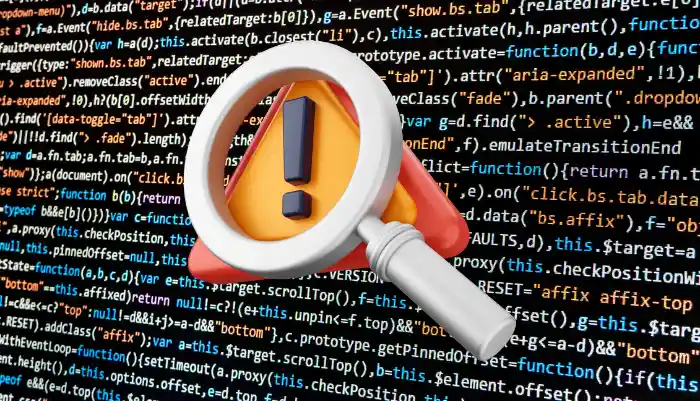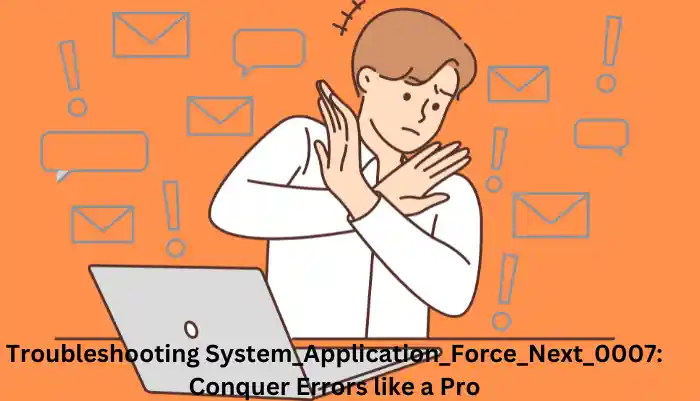Troubleshooting System_Application_Force_Next_0007: Conquer Errors like a Pro
Ever had to deal with the tricky “System_Application_Force_Next_0007” error when a program freezes up? Think of it like a digital traffic cop for your computer. It kicks in when your regular methods fail to close a stuck program. You’ll find it in your system’s task manager, or force quit menu. It’s handy for unfreezing your system, fixing unresponsive apps, or closing crashed ones. Just be careful not to overuse it, as it can mess up your data. And remember, it’s just a quick fix, not a permanent solution. Try other fixes first before relying too much on System_Application_Force_Next_0007.
What is System_Application_Force_Next_0007?
System_Application_Force_Next_0007 errors are glitches in software or system applications, messing things up and causing trouble. When you encounter these errors, it means something’s wrong and needs fixing to get everything back to normal. Knowing about these errors is essential for resolving problems and running your system smoothly.
Evolution of system_application_force_next_0007
The changes in System_Application_Force_Next_0007 reflect how the software has improved in fixing errors. It started as a simple error code but has become more advanced, with better ways to diagnose and cure problems. By listening to users and making improvements, it’s crucial to keep systems stable and users happy as technology changes.
Structure Report Phrase of System Application Force Next 0007

When we discuss the structural report phrase for “System Application Force Next 0007,” we’re breaking down this error code into parts to understand what each one means. Here’s how it looks:
System: This tells us which part of the system is having trouble.
Application: It specifies which software application is running into the error.
Force Next: This part suggests moving to the next step or action.
0007: This likely represents a specific error code or identifier within the broader category of System_Application_Force_Next.
So, in a structured report phrase, we would analyze each of these elements to figure out their role in the error situation. For instance, we’d look at “System” to see what component it refers to, “Application” to identify the software involved, “Force Next” to understand what action needs to be taken next, and “0007” to pinpoint the specific error within its category.
The functionality of system_application_force_next_0007
An application stuck or not working efficiently within a system can be quickly left using the “system_application_force_next_0007” function. This is how it functions:
- Identifying the Problem: When the system notices an application causing issues like slowing down or instability, it flags it as a problem.
- Using the Function: The user or the system can use this function to deal with the problem.
- Forcing Closure: The function stops and forcefully shuts down the problematic application, skipping the usual closing steps.
- Restoring Stability: This helps the system return to normal and prevents other processes from being disrupted.
- Letting the User Know: Users might get a message confirming that the troublesome application has been closed.
So, System_Application_Force_Next_0007 is there to help fix application issues, but it’s essential to be careful with it because it could potentially cause data loss if not used correctly.
Identifying Common Errors with System_Application_Force_Next_0007
Error 1: “Failed to Initialize”
Symptoms: The application won’t start, showing an error message.
Causes: This could happen due to corrupted files, software conflicts, or insufficient resources.
Solutions: Try restarting the app or system, updating the software, checking for file issues, looking for conflicts, or allocating more resources.
Error 2: “Not Responding”
Troubleshooting: Close and reopen the app, check Task Manager for resource usage, or terminate and restart the app process.
Potential Fixes: Update the software, turn off conflicting processes, or reboot the system.
Error 3: “Access Denied”
Permission Issues: Users might be unable to access certain features or files.
Solutions: Administrators can adjust permissions, while standard users should contact support for access help.
Understanding these errors and their solutions can help users effectively deal with System_Application_Force_Next_0007 issues and keep their systems running smoothly.
Diagnosing System_Application_Force_Next_0007 Errors
When encountering System_Application_Force_Next_0007 errors, it’s essential to analyze them quickly. Here’s how:

-
Identifying Symptoms
Look out for:
– Apps freezing unexpectedly
– Your system crashes frequently
– Any error messages mentioning System_Application_Force_Next_0007
-
Using Diagnostic Tools
Try:
– Checking Task Manager to see what’s using up resources
– Looking at error logs in Event Viewer (Windows) or Console (Mac)
– Using special tools designed for diagnosing system and app issues
-
Logging and Reporting
Remember to:
– Turn on logging to keep track of errors
– Use error reporting features, if available, to send detailed reports
– Regularly review error logs to spot any trends or patterns.
Following these steps can help you effectively diagnose and fix System_Application_Force_Next_0007 errors, keeping your system running smoothly.
Resolving System_Application_Force_Next_0007 Errors

-
Troubleshooting Process:
- Identify Symptoms: Notice signs like freezes or crashes.
- Diagnose: Use tools to discover what’s causing the problem, such as conflicts or low resources.
- Address Errors: Fix issues with specific solutions and test them out.
- Document: Record what you’ve done for future reference.
-
Implementing Solutions:
- Update Software: Make sure everything’s up-to-date to fix known issues.
- Resolve Conflicts: Avoid clashes with other apps or system parts.
- Optimize Resources: Allocate enough memory and power for smooth operation.
- Repair Files: Fix any corrupted files causing problems.
- Adjust Settings: Fine-tune settings to improve performance.
-
Preventive Measures:
- Regular Maintenance: Keep the system clean and update software regularly.
- Backup Data: Always have a backup to avoid losing important files.
- User Education: Teach users how to use software properly to avoid errors.
- Monitor Performance: Monitor the system’s health to catch issues early.
- Security Measures: Keep malware and illegal access to the system.
You can keep your system safe and fix System_Application_Force_Next_0007 issues with these steps.
Advanced Techniques for System_Application_Force_Next_0007 Error Resolution
For more effective handling of System_Application_Force_Next_0007 errors, consider these expert strategies:
-
Advanced Debugging Methods
Dynamic Code Analysis: Pinpoint the specific lines or modules causing errors.
Memory Profiling: Identify and address memory-related issues.
Fault Injection: To evaluate the system’s stability, simulate error events.
-
Optimization Strategies
Resource Management: Optimize CPU, memory, and disk usage to minimize errors.
Code Optimization: Improve code efficiency and stability to reduce error occurrences.
Concurrency Control: Manage concurrent resource access to prevent conflicts.
-
Expert Tips for Swift Resolution
Version Control: Keep track of software versions to revert to stable versions quickly.
Error Monitoring: Monitor and log errors for proactive resolution.
Cross-Platform Testing: Test compatibility across different platforms to catch potential errors early.
By implementing these advanced techniques, you can resolve System_Application_Force_Next_0007 errors more effectively, ensuring smoother system performance.
Conclusion
In conclusion, effectively resolving System_Application_Force_Next_0007 errors requires using advanced debugging methods, optimizing system resources, and implementing proactive strategies. By analyzing code dynamically, managing resources efficiently, and keeping a close eye on errors, systems can overcome these challenges and improve overall performance. By applying these techniques, System_Application_Force_Next_0007 errors can become opportunities for system enhancement in today’s fast-paced digital world.
FAQs
How do I recognize a System_Application_Force_Next_0007 error?
You’ll notice your applications freezing, crashing, or showing error messages mentioning System_Application_Force_Next_0007.
Could System_Application_Force_Next_0007 errors lead to data loss?
While these errors themselves don’t directly cause data loss, forcibly terminating applications might result in losing unsaved data.
What can I do to prevent System_Application_Force_Next_0007 errors?
Keep your software updated, manage system resources efficiently, and avoid conflicts between different applications.
What steps should I take if System_Application_Force_Next_0007 doesn’t fix the issue?
If the issue continues, reboot your computer, improve your software, or contact technical support.
Are there any risks involved in using System_Application_Force_Next_0007?
Risks like accidental data loss or system failure may arise from utilizing it seriously or in excess. It must be used with care and as a last choice.
Click Here to read more about Asseturi.














Post Comment